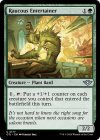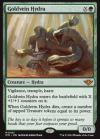this is so so cool. Man. Why is it a 3-drop that wants you to follow up on it? I'm playing it anyways, this is the neatest form of pseudo-reanimation in a long time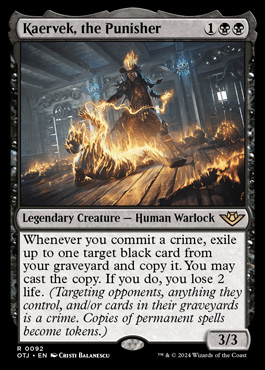
I thought WotC stopped printing Suicide Black cards?
You are using an out of date browser. It may not display this or other websites correctly.
You should upgrade or use an alternative browser.
You should upgrade or use an alternative browser.
Sets (OTJ) Outlaws of Thunder Junction Previews
- Thread starter TrainmasterGT
- Start date
I liked blocksYou mean the two times in ~25 years of Magic history where the block structure was a boon instead of a detriment?
But this is a fine solution. Gives WotC more freedom.Want to tell a before-and-after story? Stay on a plane for two sets in a row.
Really woulda made sense to suspect and investigate in OTJ and to have Azorius get Detain in MKM.Why can't we have Suspect continue into OTJ?
Hell, coulda had Plot in MKM and made these two sets into a mechanical block.Is there a reason Plot can't show up in the horror set later this year?
Why are people mad about Kellan? Because he has a Halo energy sword?I see folks mad on Reddit about Kellan, but that's, like, what I want.
Agree that this has felt sloppy. I think that the frequency of different planes as the setting is giving me some whiplash, too.I'd take the sloppy method they're doing now (Marchesa is indeed quite hard to justify, I barely got past two guild masters being part of the crew)
I like Therosto another Theros block
Overall, good post, Miles. WotC would benefit from exploring their own game/story a bit more.
Could go on a crime spree with a yard full of removal/discard. Seems like it will open up a lot of lines and the 2 life is a very appropriate downside.
Onderzeeboot
Ecstatic Orb
Honestly, mail this exact text to MaRo, please! Haven’t really looked at it this way, but that Capenna recap is spot on!Slick Sequence is nice — in general, I really think that they've done a great job with the Plot-enabled themes of the set (though I kinda wish that Geralf and Gisa didn't make yet another new Zombie token...)
Setting-wise... I feel like WotC made a bit of a devil's bargain when they got rid of blocks. Sure, there are all kinds of advantages on the design side that come from not having to worry about only getting to visit 1-2 planes a year... but on the flip side, I find all of the new planes we've visited since then really unmemorable. And I feel like the reason why is that none of the new planes have gotten sets where we get to see the status quo for the setting.
To pick an example, we didn't get New Capenna, the Demon Mobster plane where the angels all mysteriously disappeared a while ago. We got New Capenna, the Demon Mobster Plane Without Angels But It Got Invaded By Ob Nixilis So This One Character We Introduced You To Is Already Dead, And Elspeth Is There For Phyrexia-Related Reasons So She Has To Fight Him (Oh And Urabrask Is Too Because We Have A One Praetor Per Set Rule Dang It) And Remember How We Said That The Angels Were Gone? Well They Came Back Mid-Story, So The Set Has Angel Cards In It.
A lot of the post-WAR planes have felt like a version of Tarkir where they shoved Khans/Fate Reforged/Dragons into one set. We haven't gotten anything as cool as original Zendikar's revelation of what the Eldrazi are, or the fun quirk where Dragons of Tarkir replaced Khans of Tarkir in Khans Block drafts instead of adding on to it.
I liked blocks in Mirroron, Ravnica, Time Spiral, and Lorwyn/Shadowmoor. Blocks were a boon for all of those, IMO. I wasn't active during Invasion block, but that one seems cool, too. Scars of Mirrodin block was medium, but I thought New Phyrexia was a great 3rd set. Eldritch Moon was a cool second set. The latter two sets are nice payoffs that depended on block structure.You mean the two times in ~25 years of Magic history where the block structure was a boon instead of a detriment?
In my opinion, two set blocks were a good idea, and they should do those occasionally like you said. But some of the two set blocks just weren't their strongest sets, and the concept only got 5 mini blocks before they quit blocks.
I also have whiplash from bouncing around. It's pretty random. I liked the Dominaria focused cycle idea - it's too bad MOM and Aftermath were dumb. And I agree that blocks shouldn't have to include a massive apocalypse every time.
landofMordor
Administrator
Interesting! I'd love to read any secondary sources on this that you might recommend.Everyone wearing a cowboy hat is actually historically accurate. I'm not kidding.
Ever since the first Cowboy hat, the "Boss of the Plains" hat, was invented by John B. Stetson in 1865, it became indispensable for most settlers out west. Cowboy hats were good at keeping a person protected from the sun, weren't too hot to wear all day, they waterproofed to some degree so they wouldn't get soaked and become infested with mites, and they helped to keep dust out of a person's eyes. As such, within a few years, anyone working outdoors on the frontier owned a cowboy hat. This basically continued up until air conditioning made the American Southwest more habitable for people doing work that wasn't related to resource extraction.
those trains are such a travesty smhWOTC has done a lot of things wrong with the worldbuilding here. Terra Nullis, the dumb looking "trains" that aren't actually trains, and the lack of time between the opening of the Omenpaths and the set's story are all huge problems that detract from the setting. But everyone wearing cowboy hats is entirely accurate!
yes absolutely I agree on every count. neo-Westerns are interesting fictions to tell about "unimportant" communities destroyed by corruption and greed (There Will Be Blood, No Country for Old Men, Killers of the Flower Moon all come to mind), and are also important cultural artifacts in the ongoing struggle for indigenous flourishing (legally, culturally, materially, you name it). "Marvel-smirking cowboy jackasses" ain't it.The biggest issue with Modern WoTC design philosophy is treating the setting, or plane, as a backdrop and not a key-player in the world they are trying to sell. The mythologized "American Frontier" as a concept informed the actions of humans residing there. It was a harsh and unforgiving expanse that tested the human spirit and forced people to adapt in order to survive, let alone thrive. And in the true spirit of the American definition of what it means to 'thrive', it came with imperialism, genocide, extreme violence, and self-interest.
But all of the above was just outside of the reach of American and Mexican Federal Forces, allowing for conflict on a smaller scale to be unimpeded by larger powers. I just think this left room for organic conflict and storytelling.
A bunch of jackasses Marvel-smirking at the camera with a cowboy hat makes me feel nothing.

Everything Wrong with Thunder Junction.
1. Terra Nullius
Terra Nullius is a latin phrase meaning "nobody's land." It is a trope often associated with the harsh territories that were settled during the 19th and early 20th centuries, like Australia and the American West: Wide open spaces untouched by mankind. Of course, in both cases, there were already people who had been living there for thousands of years. In fact, in the case of the American Southwest, Europeans had already been there for over 350 years. While it's true that the time period between the 1860s and 1920s represented a period of major growth in European populations in this region, they were not the first. Despite this, much Western media portrayed the region as fairly empty, with rough (usually white) men "taming" the endless expanses. While this is not historically accurate, it was a common trope that is now widely regarded as erasure, especially of Native Americans.
Showcasing the American Southwest as Terra Nullius (minus an Alien Vault), reinforces harmful stereotypes about the West. While it may be easier to pretend Native Americans did not exist (or in the case of this set, pretend they are not Native to the Plane), it's almost as bad as showcasing negative stereotypes. WOTC stated that they hired cultural consultants for this set, so it is possible that they were the ones who steered the company in this direction. However, we don't really know anything about the consultant's role in the set or if this was even something they were consulting on.
2. Where it takes place in the story.
We've established that Thunder Junction is represented as Terra Nullius before the Omenpaths. The problem is that it has only been about two years since the Omenpaths first opened. Why, then, is the plane littered with Old Miner's Trails, Spirits of the Damned, and enough Zombies to make a Ghoulcaller leap with Glee? Why are there already so many boom towns and a fully developed system of Conduit Pylons? You wouldn't expect this much infrastructure to exist on the plane after only a year or two.
Likewise, how have so many villains already shown up? While some have alluded to the fact that this Plane has a bunch of Omenpaths attaching to it specifically, every Plane we've seen in the past year seems to have many high-profile connections. Ixalan alone connects to Ravnica, Eldraine, Arcavious, and Kaladesh (that we know of). Why waste time in the desert if some of the richest cities in the Multiverse are connected by the Omenpath network already? If this story had taken place a decade or so in the future, I could have seen this level of development, decay, and interest from Villains. But as the first major story post-Phyrexia, it does not make a whole lot of sense.
Funnily enough, this story could have worked at this stage in the timeline if it wasn't taking place on a Plane of Terra Nullius. I think Thunder Junction would have actually worked pretty well if there were post-apocalyptic societies of Cowboys and Native Americans. In the time before the Mending, they may have been enemies until the arrival of the Fomori. The Fomori could have built the vault, only to be defeated by a coalition of Cowboys and Native Americans after planar portal technology stopped working during the mending. The two remaining factions could have then rebuilt during the time when their plane was sealed off from the Multiverse pre-Phyrexian Invasion. When the Omenpaths finally open, we could see the two factions interacting with the flood of Villianous Visitors coming out to seek fame and fortune in various ways. The Cowboys could represent the people of Mexican or French descent living in the region before the major settlement waves, and the Native Americans could have been modeled on an interesting group from real history. Perhaps these groups could have represented law enforcement trying to handle the extraplanar visitors (which could stand in for Northern European settlers coming to North America).
3. The Trains
I'm sorry, but this looks so dumb.

This weird-looking "train" represents everything wrong with the worldbuilding of Thunder Junction. It vaguely resembles something that could be considered a train, but if you know anything about the source material, you'd realize how offensively bad of an interpretation this ended up being. These seemingly Aether-Powered locomotives feel far too futuristic for the setting. They have big, dumb, pointless wagon wheels that seemingly intersect the center of the chassis. Even though the train is on floating "tracks," the impractical wheels still occasionally touch the ground for some reason. Likewise, it is really strange to see floating strips of metal crossing the plane. Not only does it not feel like the Old West, but we're also losing a lot of the cool architecture associated with real railroads, including trestles, water towers, and tunnels. Additionally, we're running back into the Terra Nullius issue from earlier. These trains require a system of Conduit Pylonss that feel like they would have taken more than a couple of years to construct. Finally, there is no easily accessible source of Aether on Thunder Junction. They'd likely have to import it from Kaladesh in order to run the railway. As such, Aether-powered trains simply make no sense in the setting.
The most frustrating part of all of this is that the person who's overseeing this project, Ral Zarek, is the guildmaster of the Izzet League, a group known for Steam Vents and Boilerworks. These people should find it easy to whip up a rudimentary steam engine to power a locomotive that runs on traditional rails. Mine Raider shows us that traditional rails exist on the plane... so why are we stuck with dumb Aether-powered machines?
Some have argued that trains are a bit difficult to draw for artists, but I don't think that's a good excuse. There are plenty of artists who specialise in drawing trains. There are entire societies of railway artists in both the United Kingdom and the United States who know how to draw these things. There are even some fantasy artists, like Tom Colletti, who specialize in trains! For example, take a look at this piece:

This piece of art is better than literally every piece of art featuring one of the weird Thunder Junction "trains." It's colorful yet realistic, and it would look really nice on a card if it had the correct aspect ratio.
The things Thunder Junction gets Right.
While Thunder Junction does some key things wrong, I think it does still get a lot right. As a list Thunder Junction deserves praise for the following:
1) The Mechanics. I think this set has perfect mechanics for a "Western Outlaws" set. Plot looks like an awesome mechanic with good play patterns. Mount seems like it could potentially become evergreen. Spree feels chaotic, like a shootout in a cowboy movie. Even outlaw batching oozes with flavor. The mechanics are probably the most important thing for a set to get right, and I think this set passes with flying colors.
2) The Villains Theme. WOTC has been trying to make a Villain set since 2015, while Magic Origins was still being developed as an "Ally-Color Villains Core Set." Outlaws of Thunder Junction does a great job of bringing together a bunch of villains from across the multiverse into a sandbox of lawlessness and potential wealth to battle it out.
3) Native Wildlife. Magic doesn't have many opportunities to show off North American wildlife since the vast majority of sets are based on European and Asian mythology. It's nice to see Priarie Dogs and Roadrunners on cards.
4) Cowboy Hats. The fact that everyone is wearing a cowboy hat is one of the only historically "Western" things that actually made it in to the set. I like seeing that everyone has adapted to the desert environment and is wearing the proper attire. Let's be honest, it's a bit weird when Planeswalkers show up to a new world and aren't properly dressed for the elements. It's cool that everyone here is dressed up to match where they're currently working.
5) Cactusfolk. The cactusfolk are just really charming. They feel like a natural part of this sort of setting.
It's a shame that Thunder Junction dropped the ball on time scaling, indigenous representation, and the railways. The set does so much right both mechanically speaking and for its Villian theme, but the poorly executed setting cheapens the overall experience. After all, the plane is literally called Thunder Junction, yet there is not a single railroad junction to speak of. If that doesn't tell you what you need to know about the world, I don't know what would.
Thanks for Reading!
–GT
1. Terra Nullius
Terra Nullius is a latin phrase meaning "nobody's land." It is a trope often associated with the harsh territories that were settled during the 19th and early 20th centuries, like Australia and the American West: Wide open spaces untouched by mankind. Of course, in both cases, there were already people who had been living there for thousands of years. In fact, in the case of the American Southwest, Europeans had already been there for over 350 years. While it's true that the time period between the 1860s and 1920s represented a period of major growth in European populations in this region, they were not the first. Despite this, much Western media portrayed the region as fairly empty, with rough (usually white) men "taming" the endless expanses. While this is not historically accurate, it was a common trope that is now widely regarded as erasure, especially of Native Americans.
Showcasing the American Southwest as Terra Nullius (minus an Alien Vault), reinforces harmful stereotypes about the West. While it may be easier to pretend Native Americans did not exist (or in the case of this set, pretend they are not Native to the Plane), it's almost as bad as showcasing negative stereotypes. WOTC stated that they hired cultural consultants for this set, so it is possible that they were the ones who steered the company in this direction. However, we don't really know anything about the consultant's role in the set or if this was even something they were consulting on.
2. Where it takes place in the story.
We've established that Thunder Junction is represented as Terra Nullius before the Omenpaths. The problem is that it has only been about two years since the Omenpaths first opened. Why, then, is the plane littered with Old Miner's Trails, Spirits of the Damned, and enough Zombies to make a Ghoulcaller leap with Glee? Why are there already so many boom towns and a fully developed system of Conduit Pylons? You wouldn't expect this much infrastructure to exist on the plane after only a year or two.
Likewise, how have so many villains already shown up? While some have alluded to the fact that this Plane has a bunch of Omenpaths attaching to it specifically, every Plane we've seen in the past year seems to have many high-profile connections. Ixalan alone connects to Ravnica, Eldraine, Arcavious, and Kaladesh (that we know of). Why waste time in the desert if some of the richest cities in the Multiverse are connected by the Omenpath network already? If this story had taken place a decade or so in the future, I could have seen this level of development, decay, and interest from Villains. But as the first major story post-Phyrexia, it does not make a whole lot of sense.
Funnily enough, this story could have worked at this stage in the timeline if it wasn't taking place on a Plane of Terra Nullius. I think Thunder Junction would have actually worked pretty well if there were post-apocalyptic societies of Cowboys and Native Americans. In the time before the Mending, they may have been enemies until the arrival of the Fomori. The Fomori could have built the vault, only to be defeated by a coalition of Cowboys and Native Americans after planar portal technology stopped working during the mending. The two remaining factions could have then rebuilt during the time when their plane was sealed off from the Multiverse pre-Phyrexian Invasion. When the Omenpaths finally open, we could see the two factions interacting with the flood of Villianous Visitors coming out to seek fame and fortune in various ways. The Cowboys could represent the people of Mexican or French descent living in the region before the major settlement waves, and the Native Americans could have been modeled on an interesting group from real history. Perhaps these groups could have represented law enforcement trying to handle the extraplanar visitors (which could stand in for Northern European settlers coming to North America).
3. The Trains
I'm sorry, but this looks so dumb.

This weird-looking "train" represents everything wrong with the worldbuilding of Thunder Junction. It vaguely resembles something that could be considered a train, but if you know anything about the source material, you'd realize how offensively bad of an interpretation this ended up being. These seemingly Aether-Powered locomotives feel far too futuristic for the setting. They have big, dumb, pointless wagon wheels that seemingly intersect the center of the chassis. Even though the train is on floating "tracks," the impractical wheels still occasionally touch the ground for some reason. Likewise, it is really strange to see floating strips of metal crossing the plane. Not only does it not feel like the Old West, but we're also losing a lot of the cool architecture associated with real railroads, including trestles, water towers, and tunnels. Additionally, we're running back into the Terra Nullius issue from earlier. These trains require a system of Conduit Pylonss that feel like they would have taken more than a couple of years to construct. Finally, there is no easily accessible source of Aether on Thunder Junction. They'd likely have to import it from Kaladesh in order to run the railway. As such, Aether-powered trains simply make no sense in the setting.
The most frustrating part of all of this is that the person who's overseeing this project, Ral Zarek, is the guildmaster of the Izzet League, a group known for Steam Vents and Boilerworks. These people should find it easy to whip up a rudimentary steam engine to power a locomotive that runs on traditional rails. Mine Raider shows us that traditional rails exist on the plane... so why are we stuck with dumb Aether-powered machines?
Some have argued that trains are a bit difficult to draw for artists, but I don't think that's a good excuse. There are plenty of artists who specialise in drawing trains. There are entire societies of railway artists in both the United Kingdom and the United States who know how to draw these things. There are even some fantasy artists, like Tom Colletti, who specialize in trains! For example, take a look at this piece:

This piece of art is better than literally every piece of art featuring one of the weird Thunder Junction "trains." It's colorful yet realistic, and it would look really nice on a card if it had the correct aspect ratio.
The things Thunder Junction gets Right.
While Thunder Junction does some key things wrong, I think it does still get a lot right. As a list Thunder Junction deserves praise for the following:
1) The Mechanics. I think this set has perfect mechanics for a "Western Outlaws" set. Plot looks like an awesome mechanic with good play patterns. Mount seems like it could potentially become evergreen. Spree feels chaotic, like a shootout in a cowboy movie. Even outlaw batching oozes with flavor. The mechanics are probably the most important thing for a set to get right, and I think this set passes with flying colors.
2) The Villains Theme. WOTC has been trying to make a Villain set since 2015, while Magic Origins was still being developed as an "Ally-Color Villains Core Set." Outlaws of Thunder Junction does a great job of bringing together a bunch of villains from across the multiverse into a sandbox of lawlessness and potential wealth to battle it out.
3) Native Wildlife. Magic doesn't have many opportunities to show off North American wildlife since the vast majority of sets are based on European and Asian mythology. It's nice to see Priarie Dogs and Roadrunners on cards.
4) Cowboy Hats. The fact that everyone is wearing a cowboy hat is one of the only historically "Western" things that actually made it in to the set. I like seeing that everyone has adapted to the desert environment and is wearing the proper attire. Let's be honest, it's a bit weird when Planeswalkers show up to a new world and aren't properly dressed for the elements. It's cool that everyone here is dressed up to match where they're currently working.
5) Cactusfolk. The cactusfolk are just really charming. They feel like a natural part of this sort of setting.
It's a shame that Thunder Junction dropped the ball on time scaling, indigenous representation, and the railways. The set does so much right both mechanically speaking and for its Villian theme, but the poorly executed setting cheapens the overall experience. After all, the plane is literally called Thunder Junction, yet there is not a single railroad junction to speak of. If that doesn't tell you what you need to know about the world, I don't know what would.
Thanks for Reading!
–GT
Chris Taylor
Contributor
NGL, not surprised you specifically have an issue with the aetherpunk train
Atherpunk just makes no sense on the Wild West. The only reason Steampunk can work with a western setting is because the Wild West era was essentially the height of the Steam era.NGL, not surprised you specifically have an issue with the aetherpunk train
can't believe they thought they could sneak this sorry excuse for a train past the trainmaster
I'm mostly tilted over the usual stuff-in-everything-you-possibly-can at every turn. It's been overwhelming looking at new cards for a few years now and this set is no exception. Exhausting. I continue to suspect that they are leaning more heavily on AI to generate the sheer complexity and various 'knobs' and weird templating on all these designs. It's just insane how complicated everything is now.
I am also very stressed over HOW MANY returning legends there are in this set/setting, or maybe it's just a taste of this new normal we are seeing with the Omenpaths. If every plane shows up on other plane, wtf do we even need planes at that point? I think they just f'd up Magic very badly and I really don't like this "Every world is now every world" approach to the Magic multiverse. It feels so homogenous and lazy. I just don't want 20 versions of Rakdos. #KellanSyndrome
Agree the steampunk trains don't feel right and would fit better on Kaladesh. They look exactly like that, tbh.
The cactus guys are really cool, I can't disagree. Have to say I don't really like Scorpion Dragons though. Oddly enough, the idea of a Scorpion Demon doesn't really bug me at all. No idea why this is.
No idea why this is.
Cowboy hats on everyone seems fun and appropriate. It's also getting pretty obnoxious/memeish. I probably won't miss this plane when we leave.
I am also very stressed over HOW MANY returning legends there are in this set/setting, or maybe it's just a taste of this new normal we are seeing with the Omenpaths. If every plane shows up on other plane, wtf do we even need planes at that point? I think they just f'd up Magic very badly and I really don't like this "Every world is now every world" approach to the Magic multiverse. It feels so homogenous and lazy. I just don't want 20 versions of Rakdos. #KellanSyndrome
Agree the steampunk trains don't feel right and would fit better on Kaladesh. They look exactly like that, tbh.
The cactus guys are really cool, I can't disagree. Have to say I don't really like Scorpion Dragons though. Oddly enough, the idea of a Scorpion Demon doesn't really bug me at all.
Cowboy hats on everyone seems fun and appropriate. It's also getting pretty obnoxious/memeish. I probably won't miss this plane when we leave.
Last edited:
Onderzeeboot
Ecstatic Orb
I have already seen multiple cards that seem tailor made for me, and I'm much less bothered by all of the fuzz than a lot of you, for once 
To go back to the block thing a little bit... it's less that I want blocks back, and more that I really wish that we still got sets that were "here's this cool new place we're visiting!" without any overarching plot or movement. Nothing gets a chance to breathe anymore, ya know?
...
Spoilers! The only card today that really sparked joy was
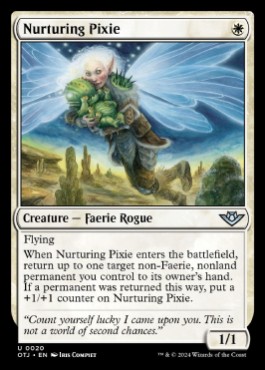
...
Spoilers! The only card today that really sparked joy was

Really like Nuturing Pixie, reminds me of Shepherd of the Flock trading the option to protect your cards from removal for a better body and counter synergies.
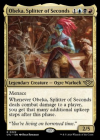
That is some pretty wild text! I would love to combo this with Bitterblossom or Dark Confidant.
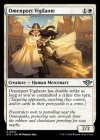
The usual 2 mana double strikers only have 1 power, this being a 2/2 is huge. Committing a crime doesn't strike me as too difficult and attacking for 4 on turn 3 is pretty good especially if you have any equipment or counters.

That is some pretty wild text! I would love to combo this with Bitterblossom or Dark Confidant.

The usual 2 mana double strikers only have 1 power, this being a 2/2 is huge. Committing a crime doesn't strike me as too difficult and attacking for 4 on turn 3 is pretty good especially if you have any equipment or counters.
Not unless they hired an internal AI team. The available AI isn't there yet. You'd have to train/program one specifically for MtG. Then again, I haven't messed with it for like six months. I still think a team of professionals would be better. Even as an individual designer, I didn't find it that lucrative.I continue to suspect that they are leaning more heavily on AI to generate the sheer complexity and various 'knobs' and weird templating on all these designs. It's just insane how complicated everything is now.
Commander!!!I am also very stressed over HOW MANY returning legends there are in this set/setting, or maybe it's just a taste of this new normal we are seeing with the Omenpaths.
I'm not liking the set, but I like a lot of the cards. Spree and Plot are really well done.I have already seen multiple cards that seem tailor made for me, and I'm much less bothered by all of the fuzz than a lot of you, for once
You're thinking too small.View attachment 9497
That is some pretty wild text! I would love to combo this with Bitterblossom or Dark Confidant.
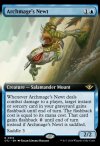
We've gotten a lot of Snapcasters this set but I really like this one.
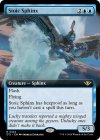
I've been trying to find a card like this for a while to act as a finisher in blue. I love the conditional hexproof, but I think it might still be too strong. Having it flash in and at only 4 mana is a lot more in-line with Magic's current pacing, power-level wise, so I just need to see if this is going to be impossible to answer/race for most decks. Seems like a very fun mini-game though.
Fun fact: this is the first 2/2 for
We've gotten a lot of Snapcasters this set but I really like this one.
To be fair, I think this card needed to be a 2/2 for 1U in order to have any chance at being good. Saddle 3 is a steep price to pay for the ability, and needing to connect means you’re unlikely to be able to get a flashback going even unsaddled in most circumstances. This feels like a fun and flashy low-power card, but probably not something for higher power formats. That said, it is both exciting and historically relevant, which is a good combination for a potentially memorable card.
Uff the “non-land” hurts. Why?
Usually it’s there to avoid us from mana disrupting the opponent. But here you can only do it to yourself if you choose to.
And there’s also minor upside in bouncing a tapped land only to play it again and exhaust your one land-play per turn. Maybe in late game you gain 1 mana where it doesn’t matter.
Funny how this discussion of blocks comes up during spoiler season for OTJ, which I still read as Odyssey-Judgment-Torment.
I feel there is a tension between story and gameplay when comparing the old block structure with modern single set approch. The former should lend itself to classic three act storytelling, but as someone with little interest in the lore I have only a vague knowledge of what those stories were. My understanding of Magic story from when I started playing is as follows:
The early years: there was some sort of world building in the background, but also quotes from Shakespeare and a whole block based on 1001 Arabian Nights, so whatever. Also there was no block structure. I then took a break from Magic until...
Tempest block: Gerrard and friends venture into and then escape from the villains lair.
Urza's block: Flashback to the olden days where everything was more powerful! Urza builds the legacy weapon out of all the broken artifacts lying around.
Masques block: Gerrard and the crew go shopping on an upside-down mountain.
Invasion block: Phyrexians invade Dominaria via Rath but are defeated by Team Gerrard using a laser made by Urza and powered by friendship. Gerrard fights Urza because he has daddy issues (I don't think Urza is his actual father, but Gerrard was one of his science projects to defeat the Phyrexians). This created the fashion for gladiatorial combat.
Odyssey block: Magic the Gladiatoring. "My name is Kamahl, fist of Krosa. Pupil of an undead dwarf, brother of a turned-into-an-abomination sister. And I will have my vengeance, in this world or the next". Kamahl wins the Mirari Trophy for being best gladiator, attaches it to the end of his sword and sticks it in the ground.
Onslaught block: Everything is weird and big and fighty; partly because of the Mirari, but also because Ixidor is having some sort of fever dream and whatever he imagines appears. He imagines an angel called Akroma, who fights with Phage and they both turn into Karona. Then I guess he wakes up because none of them show up in the story again.
Mirrodin block: Memnarch has hidden the green sun so Glissa Sunseeker has to find it because of nominative determinism. She finds it, bringing balance to the world. I've just realised that this gives thematic explanation for the unbalanced powerful cards in the first two sets and more toned down power level in Fifth Dawn.
Kamigawa block: Konda starts a war between the spirits and everyone else. His daughter stops it somehow.
Ravnica block: big city with ten guilds. Is there even a story with this one?
Time Spiral block: so much magic has happened on Dominaria that the fabric of space time is wrecked. Teferi fixes it.
Lorwyn-Shadowmoor block: a cheerful plane filled with whimsical folk turns into a horror show populated by bastards. I think this is just something that happens, like the passing of the seasons.
Alara block: a plane that had broken into five shards gets smushed back together again. Nicol Bolas did it.
Zendikar block: Zendikar is an exciting place filled with adventure, extreme weather, floating rocks and hedrons. Sarkhan Vol opens the hedrons hoping to find a dragon but accidentally unleashes a trio of cosmic horrors. Whoops.
Scars of Mirrodin block: it turns out that Phyrexian were hiding on Mirrodin all along. Fake marketing gives the impression that the Mirrans have a chance at victory. They don't.
Innistrad block: horror plane where the angel tasked with protecting the innocent is missing. Someone lets her out of the Helvault but all the demons imprisoned there also get out. It's okay, though, because the angel is so awesome she defeats the demons anyway.
Return to Ravnica block: instead of having council elections like any normal city, champions from each guild race through a maze to determine which is in charge. Izzet wins because Niv-Mizzet cheats.
Theros block: retelling of the Greek myths with the names changed, presumably to prevent lawsuits from Homer and Ovid.
Khans block: by travelling back in time to save the dragons, Sarkar splits this into a pair of two-set blocks each sharing a common set. This is so mind-boggling that WotC give up on the three set structure.
Since then we've had Totalitarian Science Fair World, where Tezerret stole someone's invention for Bolas; Egyptian World where Bolas made a secret army; Mesoamerican world where Tezerret stole another McGuffin for his boss; and Planeswalkers Assemble! where there's a big battle to prevent Nicol Bolas from destroying half the multiverse.
We've also had another arc where Phyrexia tried to invade. This is the one example I can think of where the old block structure was clearly superior from a storytelling point of view. Invasion block and Scars of Mirrodin depicted a prolonged conflict with doubt about the eventual outcome. March of the Machine gives us 36 battles across the multiverse, all of which imply victory over the Phyrexians by resolving to a powerful effect characteristic of the plane in question. My conclusion is that the Phyrexians were arrogant idiots who massively overreached themselves.
So overall I'm unconvinced that the block structure gave us better stories, though acknowledge that I'm not really the target audience.
I do recall problems with design and play during the three set block era. Mechanical themes sometimes felt overstretched by the third set; there could be issues with drafting, making it harder to have synergistic decks if you are less likely to get the necessary build-around cards; the third set would be opened less making it harder to get the chase cards. With the current approach, mechanics are still expanded upon and developed, but with the advantage that designers have been able to see how they are received by the wider community, and with more time to build on them. The return of adventures in WOE is a good example of this in my opinion. Having them as two coloured was a predictable development, but I think they were better balanced than they would have been if designers had to rely on internal play testing.
As well as the shift from block design there have been many other changes to Magic products. The largely forgettable, plane agnostic Core Sets have gone, to be replaced by ever increasing numbers of planes, universes beyond, commander products, etc. I am sure that this also contributes to feeling overwhelmed.
I feel there is a tension between story and gameplay when comparing the old block structure with modern single set approch. The former should lend itself to classic three act storytelling, but as someone with little interest in the lore I have only a vague knowledge of what those stories were. My understanding of Magic story from when I started playing is as follows:
The early years: there was some sort of world building in the background, but also quotes from Shakespeare and a whole block based on 1001 Arabian Nights, so whatever. Also there was no block structure. I then took a break from Magic until...
Tempest block: Gerrard and friends venture into and then escape from the villains lair.
Urza's block: Flashback to the olden days where everything was more powerful! Urza builds the legacy weapon out of all the broken artifacts lying around.
Masques block: Gerrard and the crew go shopping on an upside-down mountain.
Invasion block: Phyrexians invade Dominaria via Rath but are defeated by Team Gerrard using a laser made by Urza and powered by friendship. Gerrard fights Urza because he has daddy issues (I don't think Urza is his actual father, but Gerrard was one of his science projects to defeat the Phyrexians). This created the fashion for gladiatorial combat.
Odyssey block: Magic the Gladiatoring. "My name is Kamahl, fist of Krosa. Pupil of an undead dwarf, brother of a turned-into-an-abomination sister. And I will have my vengeance, in this world or the next". Kamahl wins the Mirari Trophy for being best gladiator, attaches it to the end of his sword and sticks it in the ground.
Onslaught block: Everything is weird and big and fighty; partly because of the Mirari, but also because Ixidor is having some sort of fever dream and whatever he imagines appears. He imagines an angel called Akroma, who fights with Phage and they both turn into Karona. Then I guess he wakes up because none of them show up in the story again.
Mirrodin block: Memnarch has hidden the green sun so Glissa Sunseeker has to find it because of nominative determinism. She finds it, bringing balance to the world. I've just realised that this gives thematic explanation for the unbalanced powerful cards in the first two sets and more toned down power level in Fifth Dawn.
Kamigawa block: Konda starts a war between the spirits and everyone else. His daughter stops it somehow.
Ravnica block: big city with ten guilds. Is there even a story with this one?
Time Spiral block: so much magic has happened on Dominaria that the fabric of space time is wrecked. Teferi fixes it.
Lorwyn-Shadowmoor block: a cheerful plane filled with whimsical folk turns into a horror show populated by bastards. I think this is just something that happens, like the passing of the seasons.
Alara block: a plane that had broken into five shards gets smushed back together again. Nicol Bolas did it.
Zendikar block: Zendikar is an exciting place filled with adventure, extreme weather, floating rocks and hedrons. Sarkhan Vol opens the hedrons hoping to find a dragon but accidentally unleashes a trio of cosmic horrors. Whoops.
Scars of Mirrodin block: it turns out that Phyrexian were hiding on Mirrodin all along. Fake marketing gives the impression that the Mirrans have a chance at victory. They don't.
Innistrad block: horror plane where the angel tasked with protecting the innocent is missing. Someone lets her out of the Helvault but all the demons imprisoned there also get out. It's okay, though, because the angel is so awesome she defeats the demons anyway.
Return to Ravnica block: instead of having council elections like any normal city, champions from each guild race through a maze to determine which is in charge. Izzet wins because Niv-Mizzet cheats.
Theros block: retelling of the Greek myths with the names changed, presumably to prevent lawsuits from Homer and Ovid.
Khans block: by travelling back in time to save the dragons, Sarkar splits this into a pair of two-set blocks each sharing a common set. This is so mind-boggling that WotC give up on the three set structure.
Since then we've had Totalitarian Science Fair World, where Tezerret stole someone's invention for Bolas; Egyptian World where Bolas made a secret army; Mesoamerican world where Tezerret stole another McGuffin for his boss; and Planeswalkers Assemble! where there's a big battle to prevent Nicol Bolas from destroying half the multiverse.
We've also had another arc where Phyrexia tried to invade. This is the one example I can think of where the old block structure was clearly superior from a storytelling point of view. Invasion block and Scars of Mirrodin depicted a prolonged conflict with doubt about the eventual outcome. March of the Machine gives us 36 battles across the multiverse, all of which imply victory over the Phyrexians by resolving to a powerful effect characteristic of the plane in question. My conclusion is that the Phyrexians were arrogant idiots who massively overreached themselves.
So overall I'm unconvinced that the block structure gave us better stories, though acknowledge that I'm not really the target audience.
I do recall problems with design and play during the three set block era. Mechanical themes sometimes felt overstretched by the third set; there could be issues with drafting, making it harder to have synergistic decks if you are less likely to get the necessary build-around cards; the third set would be opened less making it harder to get the chase cards. With the current approach, mechanics are still expanded upon and developed, but with the advantage that designers have been able to see how they are received by the wider community, and with more time to build on them. The return of adventures in WOE is a good example of this in my opinion. Having them as two coloured was a predictable development, but I think they were better balanced than they would have been if designers had to rely on internal play testing.
As well as the shift from block design there have been many other changes to Magic products. The largely forgettable, plane agnostic Core Sets have gone, to be replaced by ever increasing numbers of planes, universes beyond, commander products, etc. I am sure that this also contributes to feeling overwhelmed.
Fun fact: this is the first 2/2 forwith no downside!
Wow that’s actually wild! I have never thought about that before.
Was blue the last color to get this then?
To go back to the block thing a little bit... it's less that I want blocks back, and more that I really wish that we still got sets that were "here's this cool new place we're visiting!" without any overarching plot or movement. Nothing gets a chance to breathe anymore, ya know?
...
Spoilers! The only card today that really sparked joy was

The new and improved Glint Hawk. Really a shame that you can’t return a land. That would made it an instant include for me. That said, it may still crack my list.
C'mon man this is pretty reductive. Themes and ideas in stories are reflective of the real world and have meaning in that reflection even if they are not literal 1:1 representations. Fantasy is a means of commentary on reality, it doesn't just exist in a meaningless vacuum.But
Thunder Junction is not the Wild West. It is not America.
The end
C'mon man this is pretty reductive. Themes and ideas in stories are reflective of the real world and have meaning in that reflection even if they are not literal 1:1 representations. Fantasy is a means of commentary on reality, it doesn't just exist in a meaningless vacuum.
Yes exactly! They are reflective and NOT 1:1 representations which is exactly what I said. Thunder Junction is not Wild West and it is not America. That’s just the inspiration.

